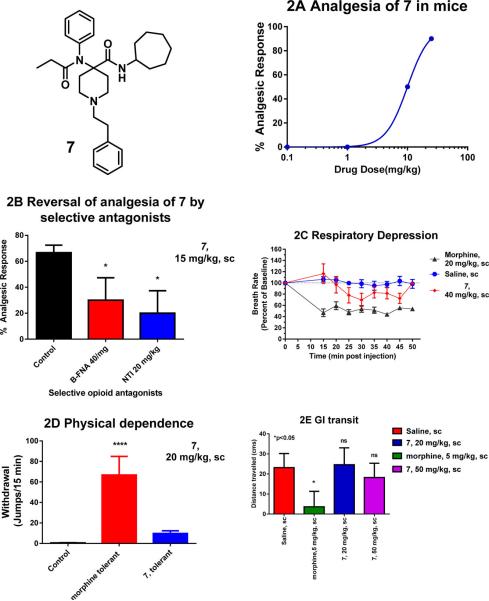Figure 2.
Pharmacology of 7. (A) Analgesia: Cumulative dose–response curves were carried out on groups of mice (n = 10) with 7 at the indicated doses (sc) and analgesia tested 30 min later at peak effect. The ED50 value was 10 ± 0 mg/kg in CD1 mice by using the radiant heat tail-flick assay. (B) Sensitivity of 7 to opioid antagonists: Groups of mice (n = 10) received a fixed dose of 7 (15 mg/kg, sc) alone or with β-FNA (40 mg/kg, sc) or NTI (20 mg/kg, sc). β-FNA was given 24h before 7 whereas NTI was given 15 min before 7. Tail flick analgesia was measured 30 min after dosing with 7. Similar results were observed in two independent replications. 7 analgesia is partially antagonized by both β-FNA and NTI (ANOVA followed by Bonferroni multiple comparison test (p < 0.05). (C) Respiratory rate. Animals were randomly assigned to receive saline (n = 5), 7 (40 mg/kg, n = 5), or morphine (20 mg/kg, n = 5). Each animal’s baseline average breath rate was measured every 5 min for 25 min before drug injection, and breath rates after drug injection are expressed as a percent of baseline. 7 did not depress respiratory rate and was not significantly different from saline at any time point, whereas morphine decreased respiratory depression in comparison with both saline and 7 (p < 0.05) as determined by repeated-measures ANOVA followed by Bonferroni multiple-comparison test. (D) Physical dependence. Groups of mice (n ≥ 10) received either morphine (10 mg/kg sc) or 7 (1 mg/kg sc) until they showed complete tolerance. They were then challenged with naloxone. Naloxone precipitated a profound withdrawal syndrome in the morphine-treated animals, as shown by the number of jumps per 15 min, which was significantly greater than that in the morphine or 7 controls (i.e., given no antagonist) or in 7 mice given naloxone. Mice chronically administered 7 showed no significant difference from controls when challenged by naloxone (1 mg/kg sc). (E) Gastrointestinal (GI) transit. Groups of mice (n = 10) received saline, morphine (5 mg/kg), or 7 (20 and 50 mg/kg) before receiving an oral dose of 0.2 mL of charcoal meal (2.5% gum tragacanth in 10% activated charcoal in water) by gavage. Animals were sacrificed 30 min later, and the distance traveled by charcoal was measured. 7 did not lower GI transit significantly compared with saline (P < 0.05), and the effect was significantly lower than that of morphine (P < 0.05) as determined by ANOVA followed by Tukey’s multiple-comparison test.

